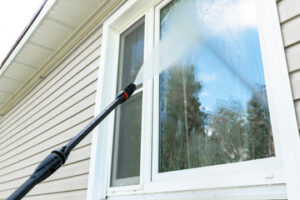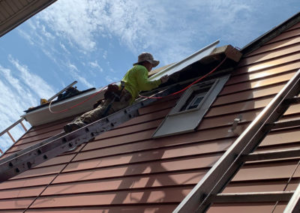Pressure washing services are no longer just about spraying water. The industry now blends physics and precision. Specialists study surface materials before cleaning. Not all grime responds to the same pressure.
Cleaning concrete differs from cleaning wood. Each surface requires tailored pressure levels. Too much power damages property. Too little leaves dirt untouched. Visit https://www.certifiedsoftwash.ca/ to learn more.

Water temperature affects cleaning outcomes. Hot water dissolves oil-based stains faster. Cold water suits delicate surfaces better. Adjusting this saves time and material wear.
Pressure washers now feature calibrated nozzles. Spray angle controls intensity and reach. Wider angles cover more space safely. Narrow ones penetrate stubborn dirt zones.
Soft washing is rising in popularity. It uses low pressure and safe detergents. This prevents erosion of roofing and siding. It’s a science-based alternative to brute force.
Chemical ratios matter in every service. Some grime needs alkaline cleaners. Others react better to acidic solutions. Professionals must calculate carefully before use.
Surfaces like asphalt have pores. Pressure washing helps release trapped pollutants. But over-washing wears them prematurely. Balancing power and gentleness is key.
Even driveway stains vary by cause. Rust needs different solutions than mildew. Organic and inorganic stains behave differently. One method cannot clean everything.
Professional services test surfaces first. A patch test prevents surprise reactions. Some sealants degrade under pressure. Others bubble when exposed to heat.
Decks can warp from water overload. Washing them requires steady hands. Water exposure must be minimal but effective. Precision defines quality on wooden surfaces.
Homeowners often overlook gutters. Pressure washing clears leaf buildup. It prevents overflow and staining. Function and appearance are restored together.
Roof cleaning involves special risk. Slippery surfaces raise safety concerns. Some tiles crack under force. Experts use harnesses and staging tools for access.
Pressure washing is part of home prep. Before painting or sealing, surfaces must be clean. Dirt creates adhesion failure. Washing ensures better, longer-lasting finishes.
Fence restoration starts with a wash. It reveals mold, splinters, and weather damage. Clean wood accepts treatments more evenly. The final look becomes smooth and bright.
Graffiti removal uses pressure too. But ink types demand tailored methods. Steam can loosen paint from porous walls. Pressure washing finishes the cleanup with care.
Parking lot cleaning improves safety. Oil spills make surfaces slippery. Cleaning them reduces accident risks. It also improves customer perception for businesses.
Even outdoor furniture benefits from pressure washing. Mold builds up unnoticed over seasons. Gentle washing refreshes their appearance. Maintenance extends their useful life.
Patio pavers collect grime in joints. Weed growth often hides beneath the surface. High-pressure washing lifts roots cleanly. A follow-up seal locks the gaps closed.
Industrial equipment also needs cleaning. Dust buildup reduces heat efficiency. Pressure washing restores operational temperature. It’s a form of preventative maintenance.
Water consumption is a key issue. Professionals recycle or restrict flow. Equipment now includes efficient pumps. Saving water while maintaining force is the goal.
Stain removal isn’t trial and error. Professionals understand stain composition. They identify the right treatment on sight. Accuracy saves both time and structure.
Washing vehicles isn’t simple either. Undercarriages collect corrosive debris. Pressure washing clears salt and mud. It prevents long-term structural rusting.
Even playgrounds require periodic cleaning. Bacteria and dirt collect on plastic surfaces. Pressure washing ensures hygiene without harsh chemicals. Children play safer after proper care.
Stone surfaces need extra caution. Some crumble under force. Specialists reduce PSI and use rotating tips. The result is clean without erosion.
Brick walls hide mold and spider webs. Washing them improves air quality. It also enhances property value subtly. Freshness is visible from afar.
Paths and walkways turn slick with algae. Pressure washing restores traction. It prevents accidental slips. Safety meets aesthetics with each sweep.
Service providers use protective barriers. Water can damage flowerbeds and light fixtures. Covering these areas prevents mishaps. Thoughtful prep shows professional care.
Cleaning boats involves different salt residues. Marine buildup hardens quickly. Pressure washing dissolves layers efficiently. Gentle technique preserves paint and polish.
Farm equipment requires periodic deep cleaning. Debris affects moving parts. Pressure washing resets operational surfaces. Hygiene also matters in food safety zones.
Construction sites rely on pressure washing too. Mud and paint splatter hinder inspections. Clean sites allow for accurate assessments. Deadlines benefit from cleaner conditions.
Event spaces get post-use cleanups. Pressure washing removes foot traffic marks. It prepares areas for next events. Turnaround speed becomes a selling point.
Tiled exteriors trap dirt in grout lines. Pressure lifts buildup deep within. Restoring original color impresses property visitors. Clean symmetry stands out immediately.
Fire damage sometimes leaves residue. Soot needs careful washing. Not all surfaces respond equally. Professionals combine pressure with chemical neutralization.
Some walls are paint-sensitive. Excessive force causes peeling. In such cases, foam application softens debris. Light rinsing finishes the task.
Waterproof coatings respond differently. Some repel pressure. Others trap water beneath bubbles. Testing compatibility avoids surface delamination.
Even playground mulch requires occasional cleaning. Dust clings to synthetic materials. Pressure washing revives color and texture. It brings spaces back to life.
Walkways with chewing gum buildup need heat. Steam and pressure dissolve hardened residue. Clean pathways improve visual appeal. They also feel more welcoming.
Athletic courts collect dirt in textured paint. Pressure washing restores traction safely. This protects players during fast movement. Performance and safety go hand in hand.
Outdoor kitchens need deep cleaning too. Grease from grills stains nearby surfaces. Pressure washing removes residue buildup. Hygiene improves dining appeal.
Retaining walls host moss colonies. These hold water against soil. Pressure washing removes growth efficiently. Structural longevity increases when walls breathe.
Solar panels benefit from careful washing. Dirt reduces energy absorption. Professionals use soft nozzles and distilled water. This protects coatings and boosts output.
Fountains and water features need algae control. Pressure washing clears buildup from pumps. Flow efficiency increases after cleaning. Visual elegance is restored.
Statues and outdoor art collect dust layers. Pressure washing exposes original detail. Special tips avoid abrasion. Art remains untouched but clean.
Pressure washing now includes remote monitoring. Sensors track pressure in real time. This prevents accidental surface damage. Precision gets smarter with technology.
Noise levels are being reduced in machines. New models minimize disruption. This matters for residential areas. Quiet operations build better customer trust.
Green cleaning is becoming a norm. Biodegradable detergents are preferred. These break down safely after use. The environment stays protected even during cleaning.
Insurance often covers pressure washing services. It becomes part of property upkeep. Regular cleaning reduces long-term damage. Smart owners schedule cleanings yearly.
Mobile pressure washers reach remote areas. Trailers bring full setups to distant properties. This expands service potential. Even off-grid spaces stay clean.
Masonry cleaning highlights craftsmanship. Dirt often hides flaws or beauty. Washing reveals workmanship again. It connects history with present care.
Exterior signage cleaning enhances branding. Dirty signs repel customers. A clean image projects professionalism. Businesses regain attention instantly.
Pressure washing isn’t just reactionary. It’s preventative too. Regular schedules maintain property health. Clean spaces uplift communities.
Future equipment will focus on AI adjustment. Pressure will auto-correct based on surface tension. This removes human error entirely. Smart cleaning will define next-generation care.

